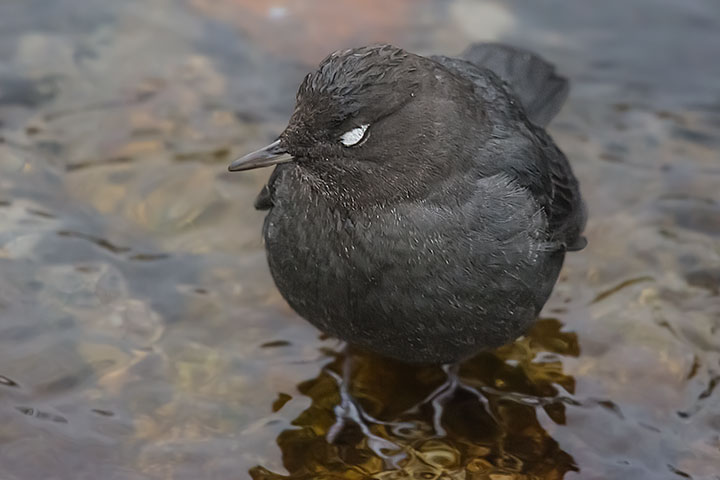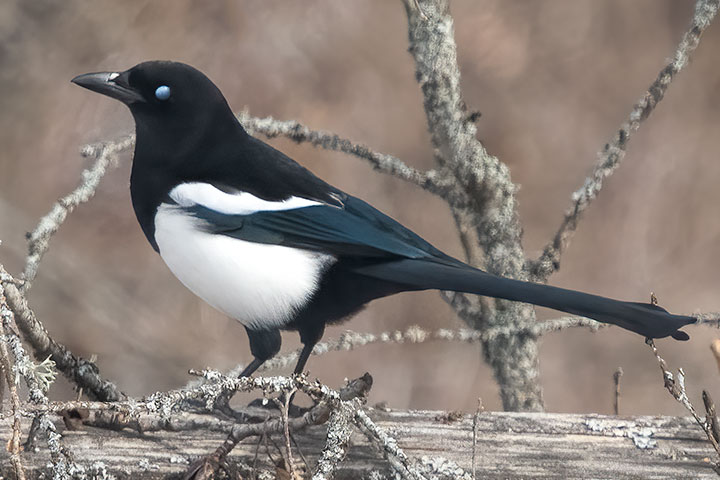Dipper – the eyelid flashes white when it blinks! This is so different from any other bird that it begs for an explanation.
David Sybley
A dipper has both a dark plumage and dark eyes. Why would it have evolved a white (feathered) eyelid? David Sybley is an authoritative author on birds who knows the literature, and yet he is unable to offer an explanation. Further, up until this morning, I would have accepted his aside that the dipper’s white eyelid was different from any other (dark) bird.
However this morning, I saw another bird with a dark head and dark eyes that sported a white eyelid. That second bird was a Black-billed Magpie. Both the dipper and the magpie are somewhat uncommon locally, yet, if you know where to look, they can be found.
When watching a dipper, I often see it flash its white eyelid. Until this morning, I had neither seen, nor suspected, that a magpie could do so also. The sight was so unexpected that I sought confirmation. I found no images of the magpie’s white eyelid on the web, but on the Cornell website, I read about the Black-billed Magpie:
In groups, males establish dominance … flashing their white eyelids.
Now, the magpie I saw was on its own, and so was not seeking dominance. However, the text did acknowledge the magpie’s white eyelid.
So, for what purpose has the white eyelid evolved? The mystery deepens.
A dipper blinks and displays its white feathered eyelid.

This morning’s shot of a magpie displaying its white eyelid.


“So, for what purpose has the white eyelid evolved?”
Darned if I know – perhaps no purpose at all – but the Magpie’s use of same is suggestive.
Bravo!!…amazingly interesting..will you communicate / share with David Sibley…?
Like so many wonderful adaptations in nature, we can only guess. Seems like a great research project for some budding wildlife biology graduate student to study and theorize! 🙂
Noodling here – to moisturize the eye ball while still being able to detect shadows/movement through the light coloured eyelid?
A reader, Neville Maytom, posed this posting’s question to Dr. David Bird, Emeritus Professor of Wildlife Biology, McGill University. Dr. Bird responded:
That is a nice and welcome response. Thank you. While I have long known about the nictitating membrane, I wasn’t aware that it would have been the membrane I was photographing. Yet, at the time, the magpie was merely feeding, so its display does remain curious. Maybe it was just protecting its eye from splattered food. I do look forward to any dipper insights.
Fascinating, Alistair. Keep challenging us with mysteries and inspiring us to open our eyes.
Do they close the white eyelids while under water? It would be very hard to tell with the difficult visibility and the membrane may disappear when submerged.
Considering that they spend so much time in the very cold water there are likely some adaptations.
It seems the only time they are warm is when they are chicks in the mossy nests.
“They’re helped in this endeavor by several physical features: nictitating membranes that act as an extra eyelid and allow them to see underwater; scales that shut over their nostrils; an extra-high lung capacity; and a low metabolism that allows them to withstand the creek’s cold. ”
from https://www.audubon.org/news/the-american-dipper